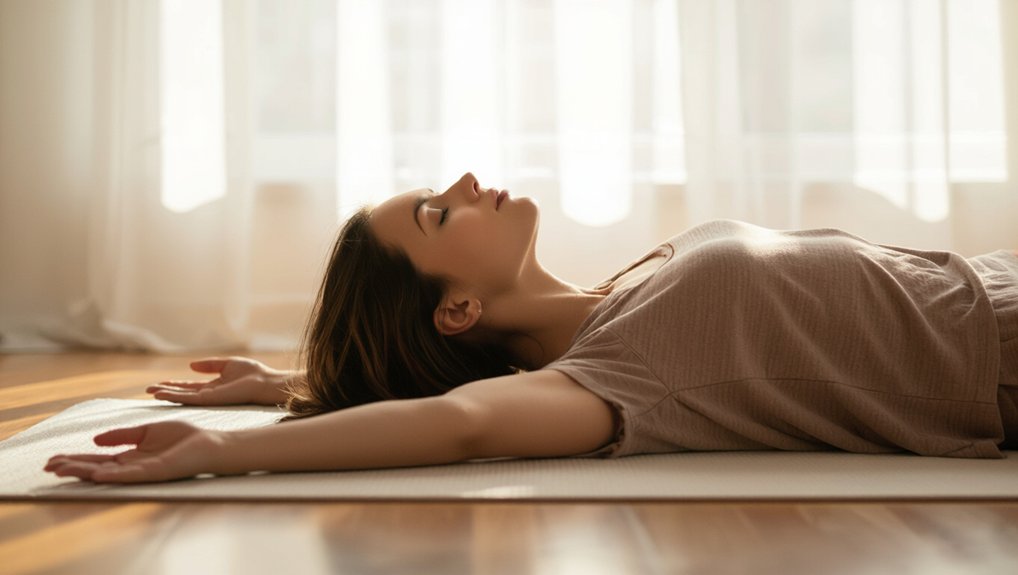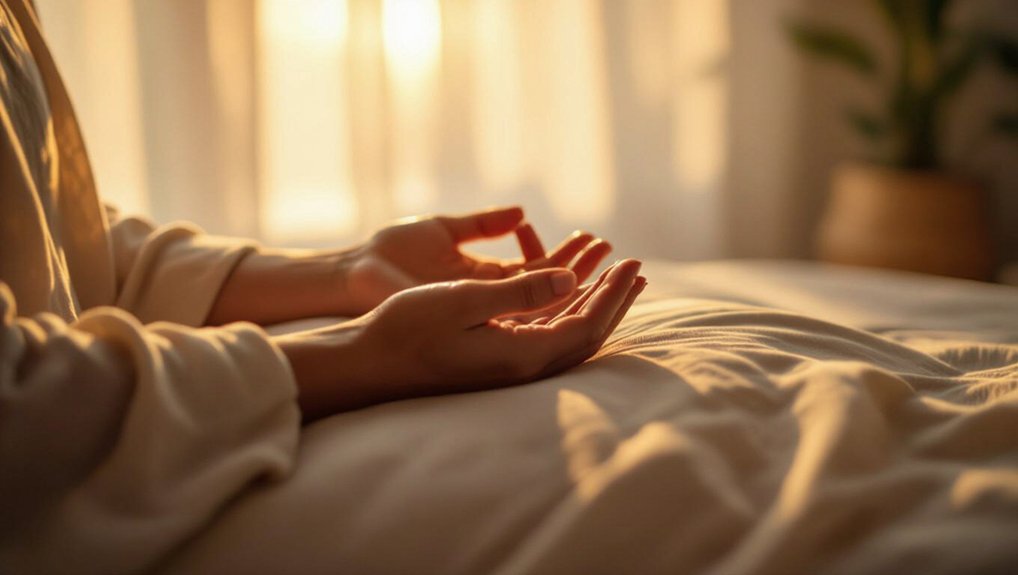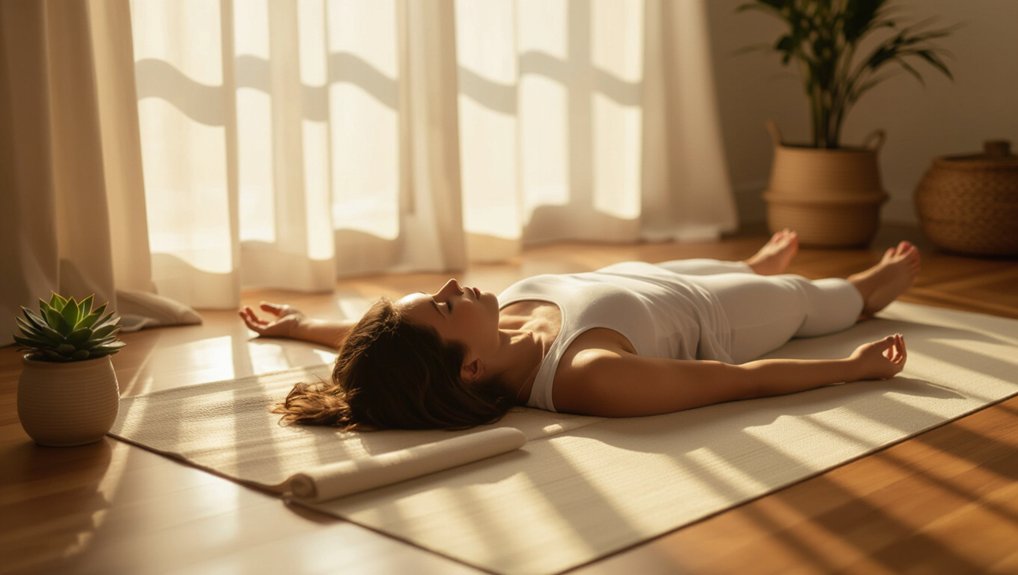You’ve likely experienced those moments when stress seems to inhabit every corner of your body—tension gripping your shoulders, fatigue weighing down your limbs, thoughts racing without pause. Body scan meditation offers a direct pathway to reclaim control over these physical and mental patterns, systematically guiding your attention through each part of your body to release what no longer serves you. But there’s more to this ancient practice than simple relaxation.
What Is Body Scan Meditation and How Does It Work?

When you practice body scan meditation, you systematically direct your attention to different parts of your body, starting from your toes and moving upward to the crown of your head. This mindfulness technique helps you develop awareness of physical sensations, tension, and areas of comfort or discomfort.
You’ll begin by focusing on each toe individually, noticing temperature, pressure, or tingling. Then you’ll move through your feet, ankles, calves, and continue upward. The process typically takes 20-45 minutes, depending on how long you spend with each body part.
Body scan meditation works by activating your parasympathetic nervous system, which triggers your body’s relaxation response. This reduces cortisol levels, lowers blood pressure, and decreases muscle tension while promoting deeper sleep and emotional regulation.
The Science Behind Body Scan Meditation for Stress Relief

Research shows that body scan meditation creates measurable changes in your brain and body that directly combat stress.
Studies using fMRI scans reveal that regular practice strengthens your prefrontal cortex while reducing activity in the amygdala, your brain’s alarm center. This shift helps you respond to stressors more calmly rather than reactively.
You’ll also experience measurable physical benefits.
Body scan meditation lowers cortisol levels, reduces blood pressure, and activates your parasympathetic nervous system. This “rest and digest” response counteracts chronic stress patterns that harm your health.
Research demonstrates that just eight weeks of consistent practice can literally rewire your brain’s stress response.
You’re training your nervous system to recognize tension earlier and release it more effectively, creating lasting resilience against daily pressures.
Physical and Mental Benefits of Regular Body Scan Practice

Body scan meditation delivers a comprehensive range of benefits that extend far beyond simple relaxation.
You’ll experience reduced muscle tension as you systematically release physical stress stored throughout your body. Your sleep quality improves dramatically when you practice regularly, helping you fall asleep faster and enjoy deeper rest.
Mentally, you’ll develop enhanced body awareness and emotional regulation skills. You’ll notice decreased anxiety levels and improved focus during daily activities. Your pain management abilities strengthen as you learn to observe discomfort without reactive judgment.
Regular practice also lowers cortisol levels, reduces blood pressure, and strengthens your immune system. You’ll find yourself responding to stressful situations with greater calm and clarity, creating lasting positive changes in both your physical health and mental well-being.
Preparing Your Space and Mind for Optimal Results

How effectively you prepare your meditation space directly impacts the quality of your body scan practice.
Choose a quiet room where you won’t be interrupted for 15-20 minutes. Dim harsh lighting or use soft lamps to create a calming atmosphere. Set your phone to airplane mode and inform household members you’re not available.
Select comfortable clothing that doesn’t restrict your breathing or circulation.
You’ll want to lie down on a yoga mat, carpet, or bed with adequate support for your spine. Keep the room at a comfortable temperature since your body temperature may drop during deep relaxation.
Before beginning, take three conscious breaths to transition from daily activities into meditation mode.
Set a clear intention for your practice, whether it’s stress relief, better sleep, or simply present-moment awareness.
Step-by-Step Guided Body Scan Meditation Instructions

With your space prepared and intention set, you’re ready to begin the actual meditation practice. Start by lying down comfortably and closing your eyes. Take three deep breaths, allowing tension to melt away with each exhale.
Begin at the top of your head. Notice any sensations—warmth, tingling, or pressure. Don’t judge; simply observe. Slowly move your attention down to your forehead, eyes, and jaw. Spend 30-60 seconds on each area.
Continue scanning through your neck, shoulders, and arms. Notice how each part feels without trying to change anything. Move through your chest, abdomen, and lower back.
Progress down to your hips, thighs, knees, and calves. End at your feet and toes. Take a moment to feel your entire body as one unified whole before gently opening your eyes.
Common Challenges and How to Overcome Them

Even with clear instructions, you’ll likely encounter obstacles during your body scan meditation practice. When your mind wanders, don’t judge yourself—simply redirect your attention back to the body part you’re focusing on.
If you feel restless or impatient, remind yourself that these sensations are temporary and part of the process. Falling asleep is common, especially when you’re tired. Try sitting upright instead of lying down, or practice with your eyes slightly open.
If you can’t feel certain body parts, that’s normal too. Simply acknowledge the absence of sensation and move forward. Physical discomfort may arise during longer sessions. Adjust your position mindfully, then return to the meditation.
Adapting the Practice for Different Needs and Time Constraints

Body scan meditation works best when it fits your lifestyle and personal circumstances. You can easily modify this practice to match your available time and specific needs.
For busy schedules, try a five-minute mini scan focusing only on major body regions: head, shoulders, chest, abdomen, and legs. When you’re extremely pressed for time, spend just two minutes scanning from head to toe without detailed attention to individual parts.
If you’re dealing with physical limitations, adapt the sequence to skip uncomfortable areas or practice while seated in a chair.
For insomnia, use a slower pace with extended pauses between body parts. Parents can practice shortened versions during children’s nap times.
Building a Sustainable Daily Body Scan Routine

Once you’ve found your preferred adaptation, establishing a consistent routine becomes your next priority. Choose a specific time that works with your schedule—morning sessions energize your day, while evening practices promote better sleep. Start with just three days per week to build momentum without overwhelming yourself.
Create environmental cues that trigger your practice: lay out your meditation cushion, set phone reminders, or link body scans to existing habits like brushing teeth. Track your sessions using a simple calendar or app to visualize progress and maintain accountability.
When you miss a day, don’t abandon the routine entirely. Simply resume the next day without self-judgment. Consistency matters more than perfection.
As the practice becomes automatic, gradually increase frequency until daily body scans feel natural and effortless.
Conclusion
You’ve discovered a powerful tool for relaxation and self-awareness through body scan meditation. By practicing this technique regularly, you’ll notice reduced stress levels, improved sleep quality, and a deeper connection with your body. Don’t let initial challenges discourage you—consistency matters more than perfection. Start with just a few minutes daily and gradually build your practice. You’re now equipped to transform your relationship with stress and cultivate lasting inner peace through mindful awareness.


